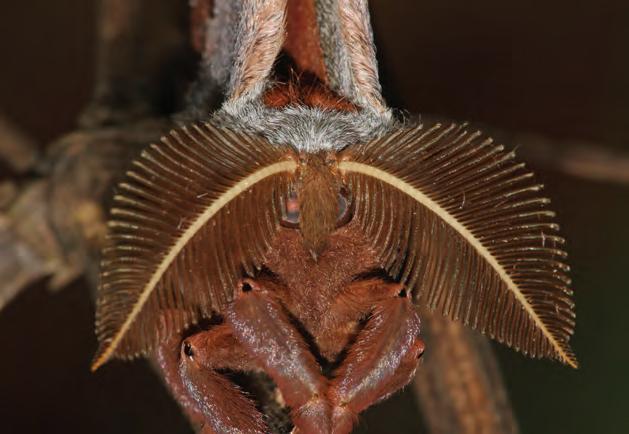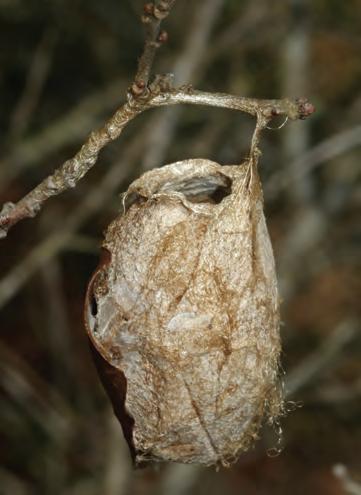
5 minute read
Discovering Host Plants of the Polyphemus Moth in Florida
Article and photos by Marc C. Minno, PhD
More than 3,000 kinds of moths (insect order Lepidoptera) are known to occur in Florida. They range in size from teeny-tiny leaf miners whose adults are just a few millimeters in wingspan to giant silk moths (Family Saturniidae) which may be six inches or more from wingtip to wingtip. A few fly in the daytime, but most sleep by day and become active at night. Whereas butterflies are relatively well-known in Florida, there is much to discover and wonder about moths!
The focus of this article is the Polyphemus moth (Antheraea polyphemus), a very large, distinctive, and handsome species of giant silk moth. The wings are a warm brown color with pink and charcoal lines and large owllike eyespots on the hindwings (Fig. 1). Perhaps you have seen one perched on a porch light or at a gas station at night?

The Polyphemus moth is a common species of forests and woodlands in Florida, except the Keys. It also occurs throughout much of the United States and southern Canada. Although this is one of our largest moths, little is actually known about the Florida population. Adults occur throughout the year but are especially common in spring and late summer into fall.
This may seem odd but Polyphemus moths are ephemeral and only live for about a week as adults. Pollinator gardens are of no use to these moths because their mouth parts are not functional. Since they cannot eat, the adults are not attracted to flowers. They rely on fat reserves and nutrients acquired during the larval stage. Males are in a hurry to find mates and females to lay eggs. With their large antennae (Fig. 2) the males can find recently emerged females emitting pheromones up to several miles away.

The eggs take two weeks or more to develop. The first stage caterpillar emerges through a hole it chews in the egg shell. The caterpillars (Fig. 3) eat the leaves of trees and shrubs and go through five larval stages. It takes five or more weeks for the caterpillars to finish feeding and spin cocoons of silk around themselves in which to form the pupal stage. Some Polyphemus moth caterpillars attach the cocoon to a twig with silk (Fig. 4). Others form their cocoons only in leaves and eventually fall to the ground when the leaves are shed.


Which plants do Polyphemus moth caterpillars eat in Florida? I have been trying to answer that question by searching trees and shrubs for cocoons. Cocoons attached to twigs (often on the lower branches of large trees) will hang for months, maybe years, after the adult has emerged.
It is easiest to spot the cocoons in December through February when many woody plants are without leaves. The oval-shaped cocoons are about 1.5 inches in length. In sunshine, the whitish silk stands out from brown leaves making them relatively easy to find with a little practice. I can often spot the cocoons on willows growing in roadside ditches as I’m driving. Other drivers often become annoyed as I yell “Stop! There’s a Polyphemus cocoon!”
Oaks, river birch, and willows are preferred hosts in Florida, but Heppner et al. (2003) list nearly 40 species of trees and shrubs reported as host plants of the Polyphemus moth from throughout its range. Elsewhere pines, pear, plum, apple, grape, sycamore, sassafras, basswood, black walnut, hickories, tuliptree, loblolly bay, and roses have been reported as hosts. Are these and other plants also eaten in Florida?
I need your help with this project!
If you find a Polyphemus moth cocoon attached to a tree or shrub, I would greatly appreciate the specimen. Just clip the cocoon and twig from the plant and place it in a small plastic bag with a label (include collector’s name, date, plant name, and location – Florida county and place). Mail the specimen in a padded envelope to my address below.
The specimens will be donated to the Florida Museum of Natural History in Gainesville for other scientists to study. I am also happy to receive photos of the caterpillars or cocoons with the host plant and other information. I am waiting to see what hosts you will discover!
Mail specimens to
Marc C. Minno
600 NW 35th Terrace, Gainesville, FL 32607 MarcCMinno@gmail.com
References
Heppner, J.B. in collaboration with W.L. Adair, Jr., H.D. Baggett, T.S. Dickel, L.C. Dow, T.C. Emmel, and D.H. Habeck. 2003. Lepidoptera of Florida. Part 1. Introduction and catalog. Florida Department of Agriculture and Consumer Services, Arthropods of Florida and Neighboring Land Areas 17: x + 670 pp.
About the Author
Marc C. Minno has studied butterflies and moths for most of his life. He received a BS degree in entomology from Purdue University, an MS degree in entomology from the University of California at Davis, and a PhD in zoology from the University of Florida. He is the author of several books including Florida Butterfly Gardening: A Complete Guide to Attracting, Identifying, and Enjoying Butterflies, and Florida Butterfly Caterpillars and Their Host Plants.

